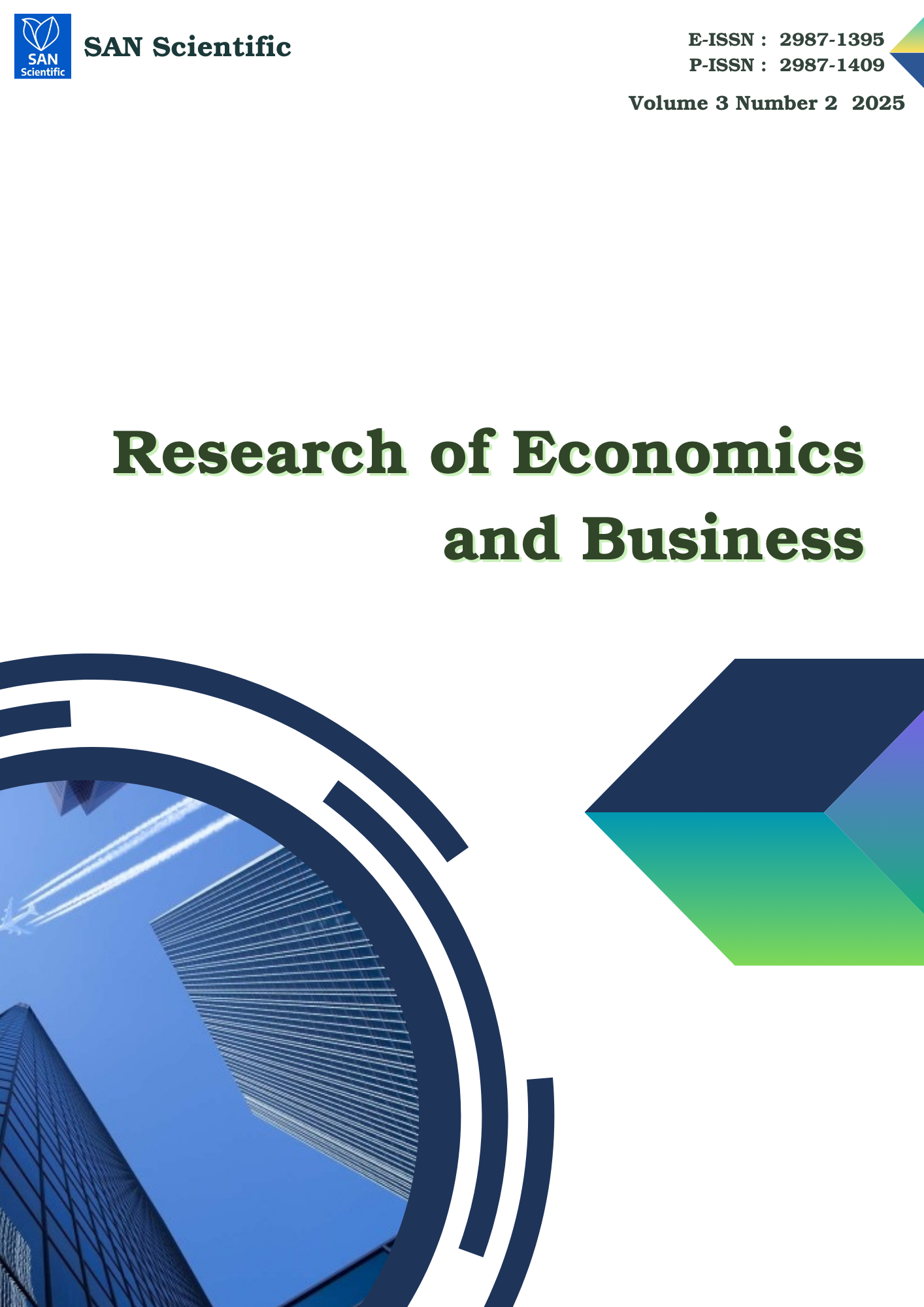Macroeconomic Determinants of Stock Returns in the Indonesian Food and Beverage Industry
DOI:
https://doi.org/10.58777/reb.v3i2.499Keywords:
Macroeconomics, Beta, Stock Returns, Covid-19 PandemicAbstract
The objective of this study is to examine the influence of macroeconomic variables specifically exchange rates, interest rates, and inflation on stock returns, both directly and indirectly through beta, within the food and beverage sector. Additionally, it explores the impact of the COVID-19 pandemic. This research adopts a quantitative approach, targeting companies listed on the Indonesia Stock Exchange within the food and beverage industry. Secondary data, sourced through library research, underpins the study, which employs panel data analysis as a primary method. The findings indicate that inflation does not negatively affect stock returns, similar to interest rates and exchange rates, which also show no adverse impact. Furthermore, the COVID-19 pandemic was found to have no positive influence on stock returns in this sector. Regarding systematic risk, beta appears to diminish the effect of inflation, interest rates, and exchange rates on stock returns, while it does not amplify the impact of the COVID-19 pandemic. These results carry significant implications for managers and investors, suggesting that external macroeconomic conditions and beta are not the key determinants of stock returns.
References
Afiyati, D., & Topowiyono, T. (2018). The effect of interest rates on stock returns: Evidence from Indonesia. Jurnal Ilmu Manajemen, 6(3), 215–223.
Appelt, S. (2016). Interest rate theories revisited: Keynes, liquidity preference, and modern implications. Economic Journal, 126(598), 145–162.
Celebi, K., & Hönig, M. (2019). The Impact of Macroeconomic Factors on the German Stock Market: Evidence from the Crisis, Pre-Crisis, and Post-Crisis Periods. International Journal of Financial Studies, 7(1), 15. https://doi.org/10.3390/ijfs7010015
Chan, K. (2015). Exchange rate regimes and their implications for emerging markets. Journal of Economic Policy, 12(2), 88–105.
De Sousa, R., Gencay, R., & Ortiz, H. (2018). The impact of exchange rate and inflation on stock returns: Evidence from emerging markets. Emerging Markets Review, 37, 152–167. https://doi.org/10.1016/j.ememar.2018.05.004
Djajadi, M., & Yasa, G. W. (2018). Analysis of beta and earnings per share on stock returns in Indonesia. Jurnal Ekonomi dan Bisnis, 21(2), 201–220.
Fama, E. F. (1970). Efficient capital markets: A review of theory and empirical work. Journal of Finance, 25(2), 383–417.
Giri, A., & Joshi, P. (2017). The Impact of Macroeconomic Indicators on Stock Returns: Evidence from India. International Journal of Financial Research, 8(2), 54–69. https://doi.org/10.5430/ijfr.v8n2p54
Haider, S., Anjum, N., Sufyan, M., Khan, F., & Ullah, R. (2014). Inflation, exchange rate, and firm performance: Evidence from Asian markets. Asian Economic and Financial Review, 4(3), 341–355.
Indriastuti, M., & Nafiah, S. (2017). The effect of market risk, exchange rate, and trading volume on stock returns. Jurnal Ekonomi dan Bisnis, 20(1), 45–59.
Jabar, A., & Cahyadi, A. (2020). The Effects of Exchange Rate, Inflation, Beta, and BI Rate on Islamic Stock Returns in Indonesia. Jurnal Akuntansi dan Keuangan Islam, 8(2), 101–113. https://doi.org/10.35836/jakis.v8i2.144
Kayo, A. E., de Oliveira, G. F., & Famá, R. (2020). Systematic risk and firm value: Evidence from CAPM testing in emerging markets. Emerging Markets Finance & Trade, 56(4), 792–808. https://doi.org/10.1080/1540496X.2018.1553169
Kyereboah-Coleman, A., & Agyire-Tettey, K. F. (2008). The Effect of Macroeconomic Indicators on Stock Market Performance: The Case of Ghana. Journal of Risk Finance, 9(4), 365–378. https://doi.org/10.1108/15265940810895025
Lintner, J. (1965). The valuation of risk assets and the selection of risky investments in stock portfolios and capital budgets. Review of Economics and Statistics, 47(1), 13–37.
Lokadata. (2020). Perkembangan indeks sektoral 2020. Retrieved from https://lokadata.id
Ouma, W. N., & Muriu, P. (2014). The Impact of Macroeconomic Variables on Stock Market Returns in Kenya. International Journal of Business and Commerce, 3(11), 1–31.
Rozak, A. (2013). The Influence of Interest Rates on Stock Returns: Evidence from Indonesia. Jurnal Manajemen dan Akuntansi, 14(1), 67–79.
Ruhomaun, K., Subadar, A., & Boodhoo, D. (2019). Exchange rate volatility and stock return: Evidence from African markets. African Journal of Economic Policy, 26(1), 33–49.
Santosa, P. W. (2019). Financial performance, exchange rate and stock return: Evidence from manufacturing sector. Jurnal Manajemen Teknologi, 18(3), 205–217. https://doi.org/10.12695/jmt.2019.18.3.5
Santosa, P. W. (2020). The Effect of Financial Performance and Innovation on Leverage: Evidence from Indonesian Food and Beverage Sector. Organizations and Markets in Emerging Economies, 11(22), 367–388. https://doi.org/10.15388/omee.2020.11.38
Santosa, P. W., & Hidayat, A. (2014). Riset Terapan: Teori dan Aplikasi (First Edit). Globalstat Solusi Utama.
Santosa, P. W., & Laksana, H. Y. (2011). Value at Risk , Market Risk and Trading Activity: CAPM Alternative Model. Journal of Applied Finance & Banking, 1(4), 239–268.
Santosa, P. W., & Puspitasari, N. (2019). Corporate Fundamentals, Bi Rate And Systematic Risk: Evidence From Indonesia Stock Exchange. Jurnal Manajemen, 23(1), 40–53. https://doi.org/10.24912/jm.v23i1.443
Saputra, R., & Wardoyo, W. (2019). The effect of return on assets, earnings per share, inflation rate, and interest rate on stock returns of Indonesian banks. Jurnal Manajemen dan Bisnis, 6(1), 67–79.
Sharpe, W. F. (1964). Capital asset prices: A theory of market equilibrium under conditions of risk. Journal of Finance, 19(3), 425–442.
Suyati, Y. (2015). Inflation, exchange rate, and interest rate: Their impact on investment decisions. Jurnal Ekonomi Pembangunan, 13(2), 88–99.
Downloads
Published
Issue
Section
Copyright (c) 2025 Fahri Gunawan Siagian, Pardomuan Sihombing

This work is licensed under a CC Attribution-ShareAlike 4.0
 Views: 12
|
Views: 12
|
 Downloaded: 11
Downloaded: 11









